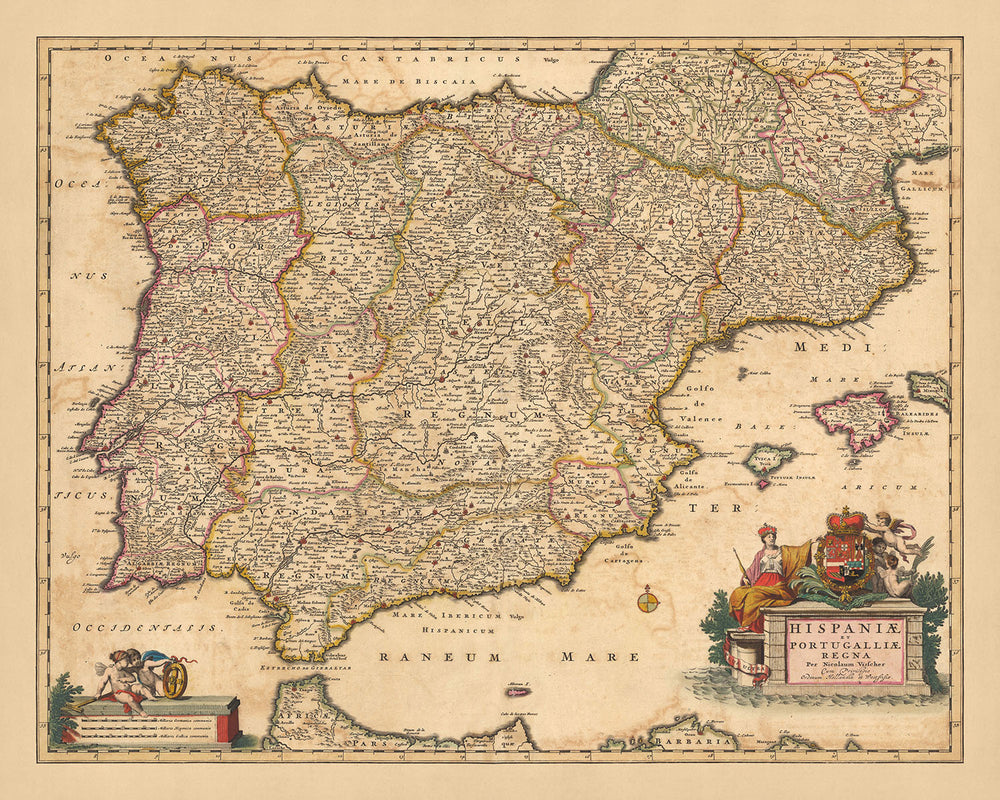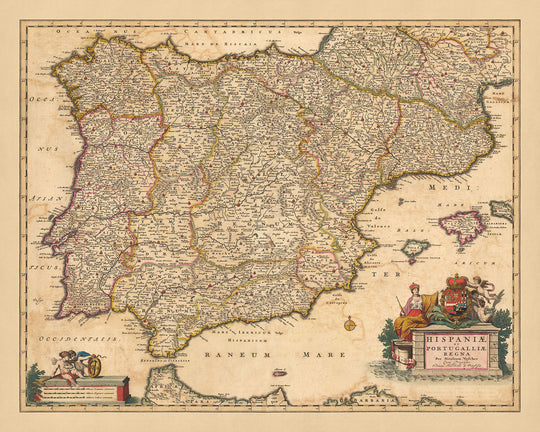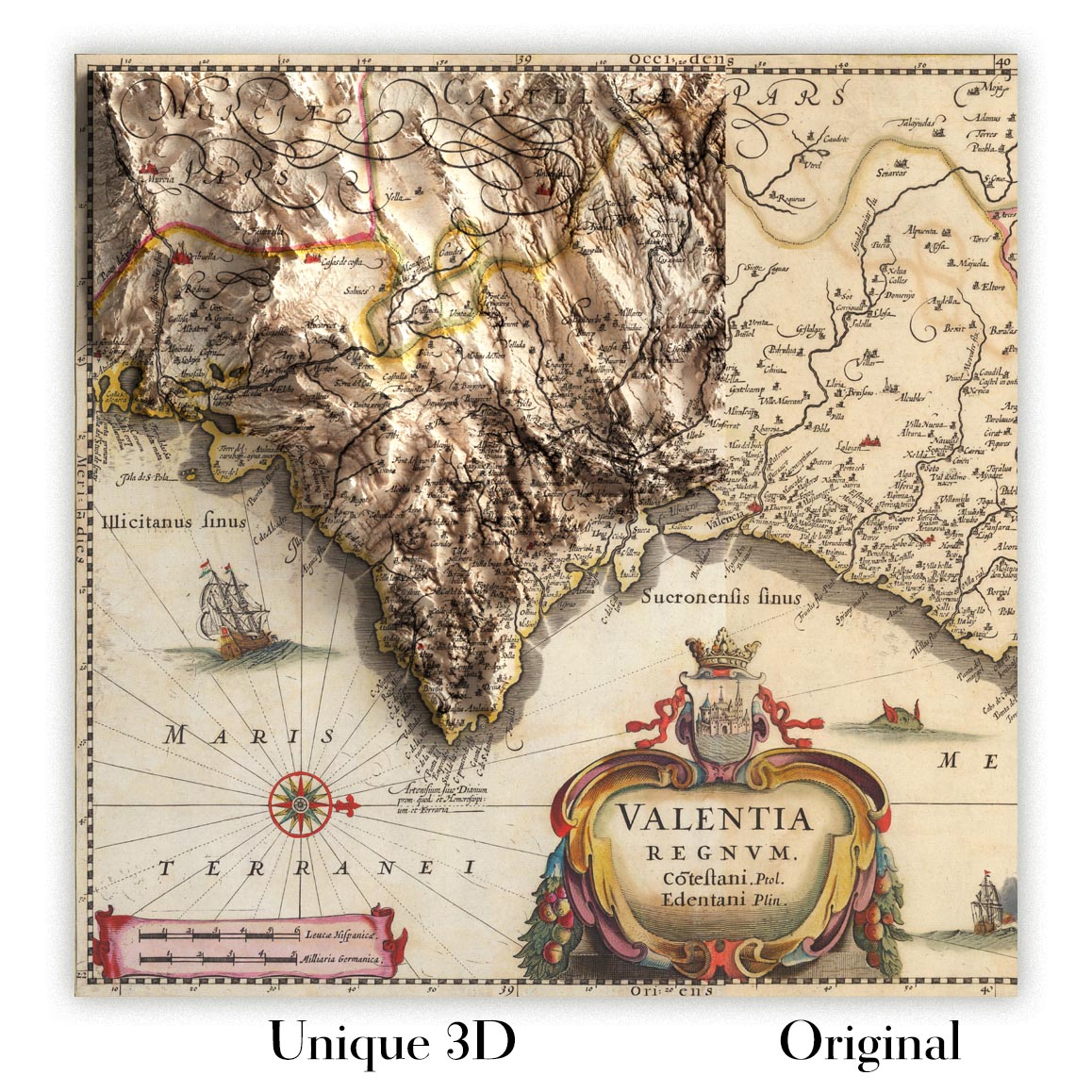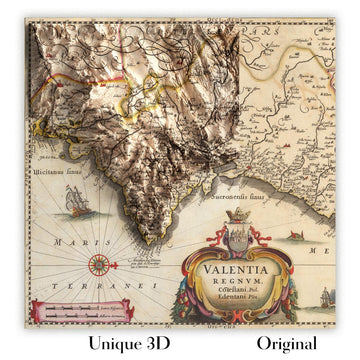- Handmade locally. No import duty or tax
- FREE Delivery by Christmas
- Love it or your money back (90 days)
- Questions? WhatsApp me any time
Own a piece of history
5,000+ 5 star reviews


Unearth the rich tapestry of the past with our meticulously detailed map, 'Hispaniae et Portugalliae Regna' - a Latin title that translates to 'The Kingdoms of Spain and Portugal'. Crafted by the celebrated mapmaker Nicolaes Visscher II in 1690, this exquisite map invites you on a journey through time, presenting an accurate depiction of the political and administrative divisions of the Iberian Peninsula during the late 17th century. Visscher, a member of the esteemed Visscher family of cartographers, was known for his remarkable precision and artistry, hallmarks that are clearly visible in this masterpiece.
The map's geographical scope encompasses the modern-day territories of Spain and Portugal, and showcases a number of significant cities including Madrid, Lisbon, Barcelona, Gibraltar, and Porto. Each city is rendered with painstaking accuracy, offering a unique window into the urban landscapes of the time. The map also highlights a myriad of natural features such as forests, waterways, canals, and mountains, providing a comprehensive overview of the region's diverse terrain.
In addition to its geographical details, 'Hispaniae et Portugalliae Regna' is a visual feast of decorative elements. The map is adorned with ornate cartouches, a coat of arms, and a compass rose, elements that not only enhance its aesthetic appeal but also provide valuable insights into the artistic conventions of the period. The map's hand-colored outlines further accentuate its visual charm, lending it a vibrant and captivating allure.
Beyond its visual and geographical elements, 'Hispaniae et Portugalliae Regna' also serves as a historical document, chronicling the political landscape of the Iberian Peninsula in the late 17th century. The map's detailed depiction of political and administrative boundaries offers a glimpse into the region's complex political history, making it an invaluable resource for history enthusiasts and collectors alike. With its blend of historical accuracy, artistic craftsmanship, and geographical detail, 'Hispaniae et Portugalliae Regna' is more than just a map - it's a portal to a bygone era.
Some of the significant locations shown on this map:
Kingdom of Spain
- Madrid: Known as the capital of Spain, it was already a significant city by 1690. Historical name: Mayrit.
- Barcelona: An important city on the northeastern coast of Spain, known for its rich history and culture. Historical name: Barcino.
- Seville: Located in southern Spain, it was the economic center of the Spanish empire due to its port. Historical name: Hispalis.
- Valencia: Known for its arts and sciences, it's located on the southeastern coast. Historical name: Valentia.
- Zaragoza: Located in northeastern Spain, it's known for its landmarks like the Basilica of Our Lady of the Pillar. Historical name: Caesaraugusta.
- Malaga: A port city in southern Spain, known for its high-rise hotels and resorts. Historical name: Malaka.
- Murcia: Known for its agriculture, especially its vineyards. Historical name: Mursiya.
- Palma: The capital city of the Balearic Islands, known for its beach resorts. Historical name: Palma.
- Bilbao: Located in northern Spain, it's known for the Guggenheim Museum Bilbao. Historical name: Bilbo.
- Valladolid: Once the capital of Spain, it's known for its historic buildings. Historical name: Pucela.
- Cordoba: Known for the Great Mosque of Cordoba, an important Islamic landmark. Historical name: Qurtuba.
- Toledo: Known for its medieval Arab, Jewish and Christian monuments. Historical name: Toletum.
- Granada: Known for the Alhambra, a Moorish citadel and palace. Historical name: Gharnata.
- Salamanca: Known for the University of Salamanca, one of the oldest universities in Europe. Historical name: Salamantica.
- Burgos: Known for its Gothic cathedral, a UNESCO World Heritage Site. Historical name: Burgus.
Kingdom of Portugal
- Lisbon: The capital of Portugal, it's known for its colonial history. Historical name: Olisipo.
- Porto: Known for its stately bridges and port wine production. Historical name: Portus Cale.
- Viseu: Known for its historical buildings, especially the Viseu Cathedral. Historical name: Viso.
- Braga: Known for its religious history and monuments, like the Braga Cathedral. Historical name: Bracara Augusta.
- Coimbra: Known for the University of Coimbra, one of the oldest universities in continuous operation in the world. Historical name: Conimbriga.
- Setubal: Known for its fishing industry and natural parks. Historical name: Caetobriga.
- Faro: Known for its preserved medieval quarters and lively nightlife. Historical name: Ossonoba.
- Evora: Known for its well-preserved old town center, still partially enclosed by medieval walls. Historical name: Ebora.
- Guarda: Known for its high altitude and historic cathedral. Historical name: Guarda.
- Beja: Known for its rich history and the Beja Castle. Historical name: Pax Julia.
- Santarem: Known for its gothic churches. Historical name: Scalabis.
- Portalegre: Known for its tapestry and silk manufacturing. Historical name: Portalegre.
- Castelo Branco: Known for its historical buildings and gardens. Historical name: Castelo Branco.
- Aveiro: Known for its canals and colorful moliceiro boats. Historical name: Aveiro.
- Leiria: Known for its castle and historic city center. Historical name: Leiria.
Notable Natural Phenomena
- Pyrenees: A range of mountains forming a natural border between Spain and France.
- Sierra Nevada: A mountain range in southern Spain known for its unique flora and fauna.
- Tagus River: The longest river on the Iberian Peninsula, flowing through Spain and Portugal.
- Douro Valley: A notable wine region in Portugal.
- Ria Formosa: A network of islands and lagoons along the Algarve coast in Portugal.
Notable Historical Events (1600-1690)
- The Treaty of Madrid (1661): Ended the conflict between Spain and Portugal over territories in the Americas and Asia.
- The Portuguese Restoration War (1640-1668): Led to the end of the Iberian Union and the recognition of Portugal's sovereignty.
- The expulsion of the Moriscos (1609-1614): A mass expulsion of Muslims from Spain by King Philip III.
Please double check the images to make sure that a specific town or place is shown on this map. You can also get in touch and ask us to check the map for you.
This map looks great at all sizes: 12x16in (30.5x41cm), 16x20in (40.5x51cm), 18x24in (45.5x61cm), 24x30in (61x76cm), 32x40in (81.5x102cm), 40x50in (102x127cm), 48x60in (122x153cm) and 56x70in (142x178cm), but it looks even better when printed large.
I can create beautiful, large prints of this map up to 90in (229cm). Please get in touch if you're looking for larger, customised or different framing options.
The model in the listing images is holding the 16x20in (40.5x51cm) version of this map.
The fifth listing image shows an example of my map personalisation service.
If you’re looking for something slightly different, check out my collection of the best old maps of Europe and European cities to see if something else catches your eye.
Please contact me to check if a certain location, landmark or feature is shown on this map.
This would make a wonderful birthday, Christmas, Father's Day, work leaving, anniversary or housewarming gift for someone from the areas covered by this map.
This map is available as a giclée print on acid free archival matte paper, or you can buy it framed. The frame is a nice, simple black frame that suits most aesthetics. Please get in touch if you'd like a different frame colour or material. My frames are glazed with super-clear museum-grade acrylic (perspex/acrylite), which is significantly less reflective than glass, safer, and will always arrive in perfect condition.
This map is also available as a float framed canvas, sometimes known as a shadow gap framed canvas or canvas floater. The map is printed on artist's cotton canvas and then stretched over a handmade box frame. We then "float" the canvas inside a wooden frame, which is available in a range of colours (black, dark brown, oak, antique gold and white). This is a wonderful way to present a map without glazing in front. See some examples of float framed canvas maps and explore the differences between my different finishes.
For something truly unique, this map is also available in "Unique 3D", our trademarked process that dramatically transforms the map so that it has a wonderful sense of depth. We combine the original map with detailed topography and elevation data, so that mountains and the terrain really "pop". For more info and examples of 3D maps, check my Unique 3D page.
For most orders, delivery time is about 3 working days. Personalised and customised products take longer, as I have to do the personalisation and send it to you for approval, which usually takes 1 or 2 days.
Please note that very large framed orders usually take longer to make and deliver.
If you need your order to arrive by a certain date, please contact me before you order so that we can find the best way of making sure you get your order in time.
I print and frame maps and artwork in 23 countries around the world. This means your order will be made locally, which cuts down on delivery time and ensures that it won't be damaged during delivery. You'll never pay customs or import duty, and we'll put less CO2 into the air.
All of my maps and art prints are well packaged and sent in a rugged tube if unframed, or surrounded by foam if framed.
I try to send out all orders within 1 or 2 days of receiving your order, though some products (like face masks, mugs and tote bags) can take longer to make.
If you select Express Delivery at checkout your order we will prioritise your order and send it out by 1-day courier (Fedex, DHL, UPS, Parcelforce).
Next Day delivery is also available in some countries (US, UK, Singapore, UAE) but please try to order early in the day so that we can get it sent out on time.
My standard frame is a gallery style black ash hardwood frame. It is simple and quite modern looking. My standard frame is around 20mm (0.8in) wide.
I use super-clear acrylic (perspex/acrylite) for the frame glass. It's lighter and safer than glass - and it looks better, as the reflectivity is lower.
Six standard frame colours are available for free (black, dark brown, dark grey, oak, white and antique gold). Custom framing and mounting/matting is available if you're looking for something else.
Most maps, art and illustrations are also available as a framed canvas. We use matte (not shiny) cotton canvas, stretch it over a sustainably sourced box wood frame, and then 'float' the piece within a wood frame. The end result is quite beautiful, and there's no glazing to get in the way.
All frames are provided "ready to hang", with either a string or brackets on the back. Very large frames will have heavy duty hanging plates and/or a mounting baton. If you have any questions, please get in touch.
See some examples of my framed maps and framed canvas maps.
Alternatively, I can also supply old maps and artwork on canvas, foam board, cotton rag and other materials.
If you want to frame your map or artwork yourself, please read my size guide first.
My maps are extremely high quality reproductions of original maps.
I source original, rare maps from libraries, auction houses and private collections around the world, restore them at my London workshop, and then use specialist giclée inks and printers to create beautiful maps that look even better than the original.
My maps are printed on acid-free archival matte (not glossy) paper that feels very high quality and almost like card. In technical terms the paper weight/thickness is 10mil/200gsm. It's perfect for framing.
I print with Epson ultrachrome giclée UV fade resistant pigment inks - some of the best inks you can find.
I can also make maps on canvas, cotton rag and other exotic materials.
Learn more about The Unique Maps Co.
Map personalisation
If you're looking for the perfect anniversary or housewarming gift, I can personalise your map to make it truly unique. For example, I can add a short message, or highlight an important location, or add your family's coat of arms.
The options are almost infinite. Please see my map personalisation page for some wonderful examples of what's possible.
To order a personalised map, select "personalise your map" before adding it to your basket.
Get in touch if you're looking for more complex customisations and personalisations.
Map ageing
I have been asked hundreds of times over the years by customers if they could buy a map that looks even older.
Well, now you can, by selecting Aged before you add a map to your basket.
All the product photos you see on this page show the map in its Original form. This is what the map looks like today.
If you select Aged, I will age your map by hand, using a special and unique process developed through years of studying old maps, talking to researchers to understand the chemistry of aging paper, and of course... lots of practice!
If you're unsure, stick to the Original colour of the map. If you want something a bit darker and older looking, go for Aged.
If you are not happy with your order for any reason, contact me and I'll get it fixed ASAP, free of charge. Please see my returns and refund policy for more information.
I am very confident you will like your restored map or art print. I have been doing this since 1984. I'm a 5-star Etsy seller. I have sold tens of thousands of maps and art prints and have over 5,000 real 5-star reviews. My work has been featured in interior design magazines, on the BBC, and on the walls of dozens of 5-star hotels.
I use a unique process to restore maps and artwork that is massively time consuming and labour intensive. Hunting down the original maps and illustrations can take months. I use state of the art and eye-wateringly expensive technology to scan and restore them. As a result, I guarantee my maps and art prints are a cut above the rest. I stand by my products and will always make sure you're 100% happy with what you receive.
Almost all of my maps and art prints look amazing at large sizes (200cm, 6.5ft+) and I can frame and deliver them to you as well, via special oversized courier. Contact me to discuss your specific needs.
Or try searching for something!















































